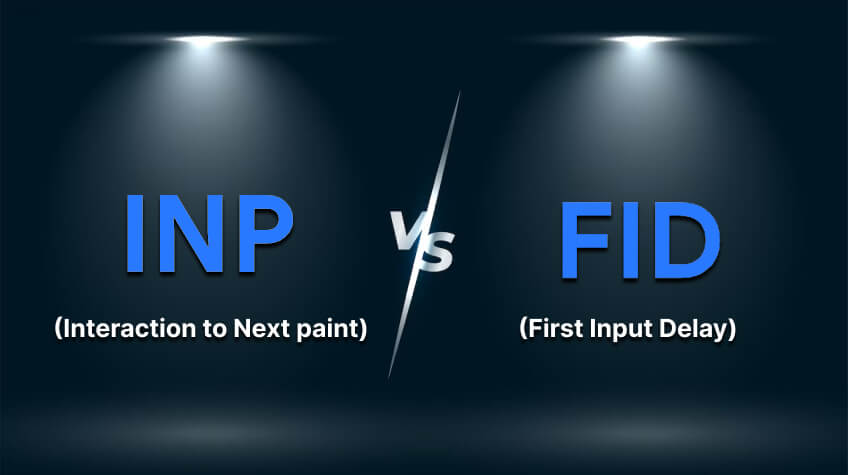
Everybody in the world of web development is talking about INP core web vital. It is because Google just announced that INP will replace FID as a primary Core Web Vitals metric in March 2024. If you’re wondering how it will impact web development and the key difference between INP vs FID, read this post.
Let’s dive in…
Table of Contents
- Google Core Web Vital Metrics
- What is FID?
- What is Interaction to Next Paint?
- Why is INP Significant?
- What are the Key Differences Between INP vs FID?
- How can INP Improve Web Performance?
- The Bottom Line
Google Core Web Vital Metrics
Web development is perpetually undergoing change in order to accommodate the requirements of an ever-expanding online audience. Core Web Vitals, released by Google in the year 2020, are a set of measures that play an important part in analyzing and improving the performance of websites.
Google core web vital metrics assess things like how quickly a page loads, how interactive it is, and how stable it looks. These metrics affect both the user experience and the ranking of the website in search engines.
Google Feature: Google unveils About this image Tool to Verify Image Source
What is FID?
The First Input Delay, commonly known as FID, is a measurement that determines how long it takes for a website to respond to the initial action taken by a user. It is considered to be one of the most important metrics tracked by Core Web Vitals. Recently, Google announced that INP will replace FID in the month of March 2024. Interaction to Next Paint (INP) will take the role of FID as a component of Core Web Vitals. INP is said to be more all-encompassing for evaluating the performance of websites.
Let’s now understand what INP is, what is the difference between INP vs FID, and how it is going to impact the performance of websites…
What is Interaction to Next Paint?
INP is a new metric that helps website owners and developers evaluate the responsiveness of the page’s collective interactions. INP gauges the time it takes for a website to respond to all user interactions.
If the Interaction to Next Paint(INP) value is greater than 500 milliseconds, it simply indicates that one or more interactions on the page take longer than 500 milliseconds to respond. If this is the case, then the page is considered to be unresponsive. Know that it can directly impact the ranking of your website on search engines.
The ideal INP score is said to be between 0 and 200 milliseconds. INP score between 0 and 200 milliseconds indicates that your website is highly responsive and interactive. Having a lower INP score is a necessity for all web owners to generate a seamless user experience.
RELATED: Unveiling Google August Broad Core Algorithm Update
Why is INP Significant?
Interaction to Next Paint or INP is all about responsiveness and user experience. We all know that user experience plays a crucial role in today’s world. For every website owner, it is crucial to have a site that loads quickly.
People in today’s world are too busy to spend time on slow websites. They expect websites to be quick and responsive. The moment a page becomes slow, they leave it to never come back. Slow website performance can result in a negative user experience, increased abandon rates, and ultimately lost revenue. That’s when INP comes in handy. It makes it easier to identify problematic areas of interaction.
INP is essential for websites that rely significantly on user interaction, such as e-commerce websites, social media platforms, and so on. A low INP score indicates that the site is responsive and offers an excellent user experience. Also, a low INP score can also have a positive effect on search engine rankings.
What are the Key Differences Between INP vs FID?
Both INP and FID are performance metrics; however, both of them are used to measure distinct aspects of the responsiveness and interactivity of a website. They may appear comparable at first inspection; however, they differ greatly based on their characteristics and applications.
INP focuses on measurements after the page load and once the user begins interacting with the page, whereas FID focuses more on page load.
INP helps recognize problematic areas of interaction. INP is crucial for websites that heavily rely on user interaction, such as e-commerce websites, social media platforms, etc. A low INP score indicates that a website is responsive and provides an excellent user experience. Additionally, a low INP score can improve its search engine rankings.
The FID metric, on the other hand, measures only the initial user input and its latency. It does not account for the complete duration of each event. It only provides a small sample of the responsiveness of the user’s experience.
INP measures the amount of time it takes for a user to interact with a page element and the subsequent paint. It measures how quickly the browser can analyze and display the result of a user’s interaction. In contrast, FID focuses on the time between a user’s initial interaction with a webpage and the browser’s capacity to respond to that interaction. It helps determine a website’s responsiveness during the initial launching phase.
When it comes to interaction timing, INP considers the entire user interaction lifecycle on a webpage. On the contrary, FID focuses solely on the initial interaction.
INP can provide information about the overall browsing experience and how well a website manages user input. While with FID, that’s not the case. First Input Delay(FID) is more concerned with the initial perception of a website’s responsiveness.
Google developed INP in response to the issues and limitations of FID. Google has announced that INP will replace FID as the Core Web Vitals metric for responsiveness in March 2024.
Although both INP and FID affect user experience, their effects are distinct. A low INP score ensures a seamless browsing experience. Whereas a low FID scores better quality images.
How can INP Improve Web Performance?
Google’s goal is to offer a stunning user experience by improving website performance. To achieve this goal, Google has incorporated INP into Core Web Vitals. Implementation of INP core web vitals acknowledges that the user experience is not exclusively driven by the initial encounter but also by future interactions inside the web page itself.
Instead of solely focusing on reducing the time between the first and subsequent user actions, INP considers all user input, allowing developers to enhance the quality of the interactive experience as a whole.
INP makes sure that the website is responsive to a variety of events, such as clicks, taps, scrolling, and other activities taken by users. This metric offers a more precise representation of how users view and interact with a website by revealing how they interact with it. By concentrating on the website’s overall interactivity and utilizing this data, developers can make informed decisions related to optimization, user interaction and ultimately improve their website’s search engine rankings.
Wrapping it up…
So, this is all about Google’s brand new INP core web vital metrics. It is solely meant to evaluate the responsiveness of websites. The current statistic used by Core Web Vitals, FID, is not as comprehensive as its successor, INP, and that’s the reason Google announced INP will replace FID in March 2024. Web developers and site owners will need to make an effort to have a thorough understanding of INP vs FID in order to make relevant adjustments to their sites.
Using PageSpeed Insights, web developers would be able to measure their website’s performance. PageSpeed Insights by Google is one of the best tools to measure INP and other Core Web Vitals metrics. It will help you understand how your site is performing in real-world conditions.
Let’s now take a look at some of the FAQs relevant to INP. Here we go…
FAQs
1. Why is Google Replacing FID with INP?
Ans: As we all know, Google is more concerned about users’ experience. Every new Cor Web Vital Metrics by Google is focused on users’ experience. When it comes to INP vs FID, INP is a new metric that assists website owners and developers in determining the responsiveness of a page’s cumulative interactions. INP measures the amount of time it takes a website to respond to all user interactions.
INP provides a more accurate picture of the user experience by taking into account subsequent interactions, in contrast to FID, which only considers the delay associated with the first user encounter.
The replacement will attempt to deliver a more all-encompassing assessment of a website’s performance.
2. How will switching from FID to INP impact web development?
Ans: This update places a greater emphasis on the value of total interactivity and the user experience. It will push developers to optimize their websites beyond merely the initial latency in receiving user input.
Web developers and site owners would be able to create user experiences that are quicker, more responsive, and more engaging. For that, they would need to have a thorough understanding of the consequences of the INP upgrade. Web developers would be able to achieve their goals of providing better online speed and higher search engine results by proactively addressing delays, analyzing the reliance on third parties, balancing the loading of resources, and using the capabilities of browsers.
It is absolutely necessary for web developers to have a thorough understanding of INP vs FID. By accepting this transition, developers will ensure that their website continues to be competitive in the rapidly shifting digital landscape.
In addition, web developers will need to adjust their optimization tactics to place a greater emphasis on minimizing wait times throughout the user experience while simultaneously increasing the level of overall interaction. Web developers would be able to improve both the overall user experience and the search engine rankings using INP-centric optimizations.
3. How is INP measured?
Ans: INP is measured in milliseconds. Several timing metrics are accessible via the Navigation Timing API, which can be used to evaluate the effectiveness of a website’s user interaction. INP will measure the time between clicks, touches, and keyboard inputs during a user’s interaction with a page.
INP is calculated by subtracting the timestamp of the first user input event (such as clicking a button or entering information in a form field) from the date of the consecutive paint event on the page. INP can be measured using a variety of tools, including web performance monitoring programmes, browser extensions, and Google’s Core Web Vitals report in Google Search Console. Using INP-centric optimizations, web designers would be able to enhance the user experience and overall performance of their websites.
4. When is Google planning to implement new INP core web vitals?
Ans: Google has announced that INP will replace FID in March 2024. Make sure your website is ready for the switch from FID to INP in 2024. Focusing on improving web performance through INP optimization can contribute to a better user experience, which is likely to have a favorable influence on search engine results, despite the fact that it is difficult to anticipate the exact impact on rankings.
5. What all adjustments do we need to make on our website?
Ans: Even if there are no particular changes that are required for the transition, it is strongly suggested that you evaluate the performance of your website in light of the new metric. Evaluate the parts of the user interactions that result in delays and then develop optimizations to reduce those delays as much as possible.
6. What is the Ideal INP Score?
Ans: Google recommends that web pages strive for an Interaction to Next Paint (INP) score of 0 – 200 milliseconds for a positive user experience. This indicates that the time between a user’s first interaction with a website and the subsequent visual change should be between 0 – 200 milliseconds.
Two hundred milliseconds or less than 200 milliseconds is considered an excellent INP score.
A score between 200 and 500 milliseconds for the INP is considered acceptable, whereas a score of 500 milliseconds or more is deemed unacceptable.
INP can vary depending on the type of website or online application, page sophistication, and user expectations. Web designers and site owners should periodically review their INP scores to improve the user experience.






